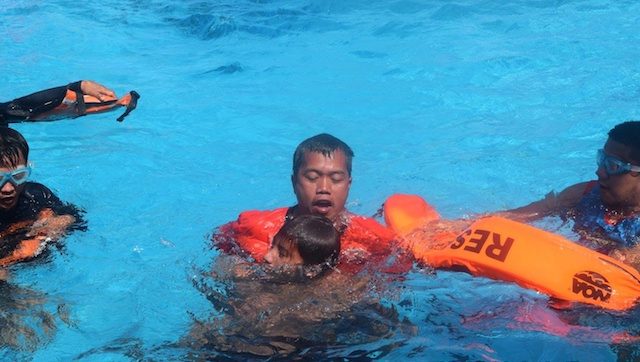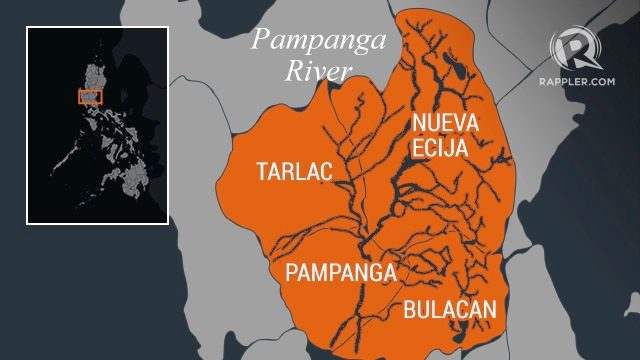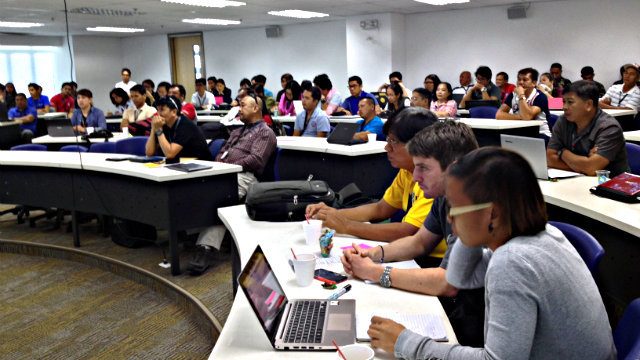SUMMARY
This is AI generated summarization, which may have errors. For context, always refer to the full article.

MANILA, Philippines – Under the searing heat of the sun, they plunged into the Pampanga River, swam a mile, and drove rubber boats against the sparkling current.
For this group of men from Macabebe town in Pampanga, it was not the beginning of their summer vacation. It was the final stretch of their water search and rescue exercise.
During the last week of February, 20 cops, firemen, and other volunteers from the local government underwent their first training on how to save lives during floods and typhoons. Before braving the river, they went through simulated search, rescue, and survival exercises in a swimming pool.
“We want to train our rescuers while there is time and the weather is fine. Their skills will be most needed during the rainy season,” said Jomel Cruz, the municipal disaster management chief.
In March, the municipal disaster risk reduction and management office (MDRRMO) will be wrapping up its series of preparedness activities. New rescue equipment and gear are also coming:
- Motorized rubber boats
- Life vests, rescue helmets, waders, raincoats, and boots
- Body harness and rescue ropes
- Megaphones and sirens
- Ladders
- Generators and flashlights
- First aid kits

Hazards in Central Luzon
Macabebe has been a laid-back town for a long town, according to Cruz. But recent disasters and warnings about extreme weather events have jolted the sleepy town.
“Ang talagang nakikita naming problema ngayon ay mga storm surges, yung mga ipo-ipo, yung biglang tataas yung tubig,” Cruz said. (What worry us now are storm surges, tornados, and flooding.)
Pampanga and the rest of the region are prone to various disasters, the state weather bureau PAGASA said. Located along the Pampanga river basin in Central Luzon, the region is susceptible to flooding. Low-lying areas, particularly those near the rivers and other bodies of water, are generally prone to flooding during the rainy season.
Four of the 7 provinces of Central Luzon – Pampanga, Tarlac, Nueva Ecija, and Bulacan are among the top 10 provinces which are highly susceptible to flooding, according to the Mines and Geosciences Bureau. These provinces are surrounded by the Pampanga River.
Facing the South China Sea, Philippine Sea, and Pacific Ocean, Zambales, Pampanga, Aurora, and Bataan are prone to tsunami, according to Phivolcs director Renato Solidum.
Back in 2004, tropical depressions Merbok and Winnie caused flooding and landslides that isolated remote villages in Aurora province. In 2013, Pampanga bore the brunt of Typhoon Maring’s onslaught, causing floods that submerged about 130 barangays. In 2011, the combined effects of the Southwest monsoon (Habagat) and Typhoon Pedring (Nesat) brought incessant rain, flooding the region.
The most devastating disaster that ever hit Pampanga was the 1991 Mt Pinatubo eruption that affected nearly 330,000 families and claimed 675 lives.
Pinatubo tragedy
The Mt Pinatubo disaster was a challenging time for many responders in affected areas, including Pampanga. After the eruption, they felt helpless everytime lahar – volcanic ash and water – flowed, washing away houses and people.
“Napapaluha na lang kami tuwing naririnig namin yung mga kababayan natin na humihingi ng tulong. Gusto man namin silang tulungan, pero wala kaming magawa dahil masyadong malakas ang pagragasa ng lahar,” policeman Elmer Garcia, who heads the Angeles City public safety regional office, recalled. (We just felt like crying everytime we hear people shouting for help. We wanted to help but we couldn’t do anything because of the lahar flow.)
Garcia, then a new cop, was deployed as a responder. Even if he and his rescue team were trained, he said they were clueless about the hazards and how to mitigate them.
“Bagama’t mayroon nga tayong information dissemination, kulang pa rin dahil hindi natin exactly nalalaman kung saan tatama ang lahar,” Garcia recalled. (We conducted information dissemination but it was not enough because we didn’t know exactly which area lahar flows would hit.)
Now that hazard maps, up-to-date weather updates, and other critical information are available, Garcia said it is easier for disaster managers and responders to prepare for disasters.
“Before dumating ‘yan, (kailangang magkaroon) ng dissemination at mabigyan ng warning ang mga residente na kailangang mag-evacuate sila para sila’y mailigtas,” Cruz said. (Before a disaster strikes, it is important to inform affected residents to evacuate for their safety.)

Information flow
Earlier in February, Garcia and Cruz joined about 100 other Central Luzon disaster managers, responders, and humanitarian groups in a workshop that introduced the online disaster information platform Project Agos. The activity highlighted best practices in the use of technology in disaster management, ranging from an inspiring village experience to an effective national crowdsourcing effort during Typhoon Ruby (Hagupit). (READ: How a small Samar town survived deadly storm surges and Online humanitarians respond with Project Agos)
“When the crowd posts pictures of floods and landslides on Facebook, Twitter or even Instagram, there better be a disaster manager monitoring the social media, getting these reports, and responding to the emergency,” said the workshop keynote speaker Allan Tabell, chief of the Department of the Interior and Local Government Central Office Disaster Information Coordinating Center (DILG-CODIX).
The training that responders attended will be put to the test when actual disasters happen, Tabell said. The DILG recently came up with a checklist of minimum early and critical preparedness actions which LGUs can easily implement, he added. (READ: Social media: Critical for disaster managers).
The LGU capacity-building workshop in Pampanga was the second in a series of workshops being conducted by Rappler’s civic engagement arm MovePH. The first one was held in November 2014 for the LGUs of the National Capital Region (NCR).
How is your LGU preparing for disasters? Share and send your story to move.ph@rappler.com. – with reports from Sarah Jayne Olan/Rappler.com
Project Agos is a collaborative platform that combines top-down government action with bottom-up civic engagement to help communities learn about climate change adaptation and disaster risk reduction.
Project Agos is managed by Rappler’s civic-engagement arm, MovePH, in partnership with various agencies of the Philippine government, civil society organizations, the private sector, and the Australian Embassy in the Philippines.
Add a comment
How does this make you feel?
There are no comments yet. Add your comment to start the conversation.